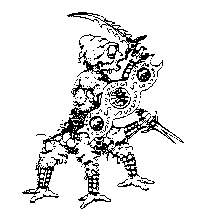Backbaird (バックベアード) is a yōkai who appears in the manga
GeGeGe no Kitaro by Shigeru Mizuki. The name has been said to be a transliteration of "Bugbear", and has also been rendered as Buckbaird, Backbeard, Bugbeard, and other variations. Other than the name, the creature has little, if any similarity to either mythical or D&D bugbears.
 You damn lolicons!
You damn lolicons!
Unfortunately, there seems to be very little interest in releasing GeGeGe no Kitaro outside of Japan, perhaps because of its 70's aesthetic, so the only material I have regarding Backbaird has been taken from the internet.
From what I can tell, Backbaird attacks by lashing out with the projections surrounding his body. He can also create additional copies of himself, and possibly induce dizziness in people who are in his presence.
Some sources suggest that he is a type of tree spirit based on the root-like projections that surround the eye, while others claim he is an embodiment of smog or shadow, but I'm not sure if these are canonical interpretations.
Unofficially, Backbaird has been invoked as a protector of young girls because of his phrase "このロリコンどもめ!" This phrase became an internet meme via the character
Beako (ベア子) who is sometimes presented as being Backbaird's daughter.
Controversy over Backbaird emerged in 2008, when the photographer Masatoshi Naito leveled charges that Mizuki
plagiarized the design from his photomontage Shinjuku-boukei・Chimera (新宿幻景・キメラ). I'm not sure if Naito had a backstory associated with his work, but the evidence seems to weigh heavily in his favor as far as the design of the creature goes.
Anyway, below is a Backbaird figure from the GeGeGe no Shigeru Yokai Emaki Series (ゲゲゲのしげる妖怪絵巻) produced by Kabaya.

I don't think Backbaird has a set size, but he often appears very large. This particular figure seems to be intended to be roughly 1/8 scale, but I think it works perfectly with 1/72 scale figures as well.
Backbaird seems to have become associated with cyclopean eyeball monsters in the Japanese videogame world, with appearances in the Wild Arms video game series, and also the Castlevania series.
In Castlevania, the Buckbaird is a tougher version of the Peeping Eye. There are
a couple of different designs depending upon the version of the game it appears in. One version seems to be able to shoot eye beams, while the other has some sort of electricity based attack.

This is an in progress shot of my attempt to model the Castlevania Buckbaird. The main body is built around a plastic pearl bead, while the end of the tail is built around a smaller spike bead. I'm still trying to decide whether the chain should be permanently affixed to the body, or if I should make it detachable.





















